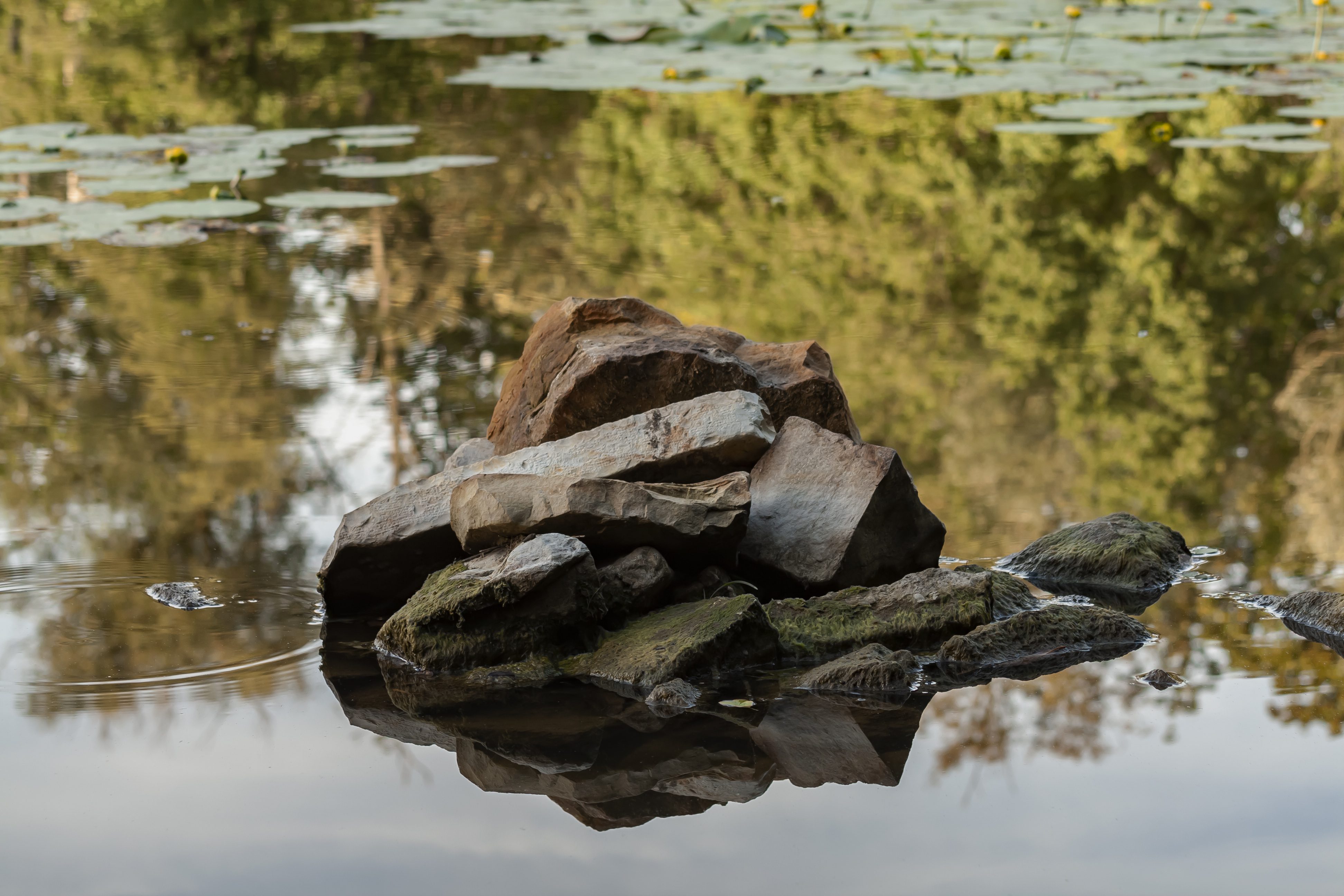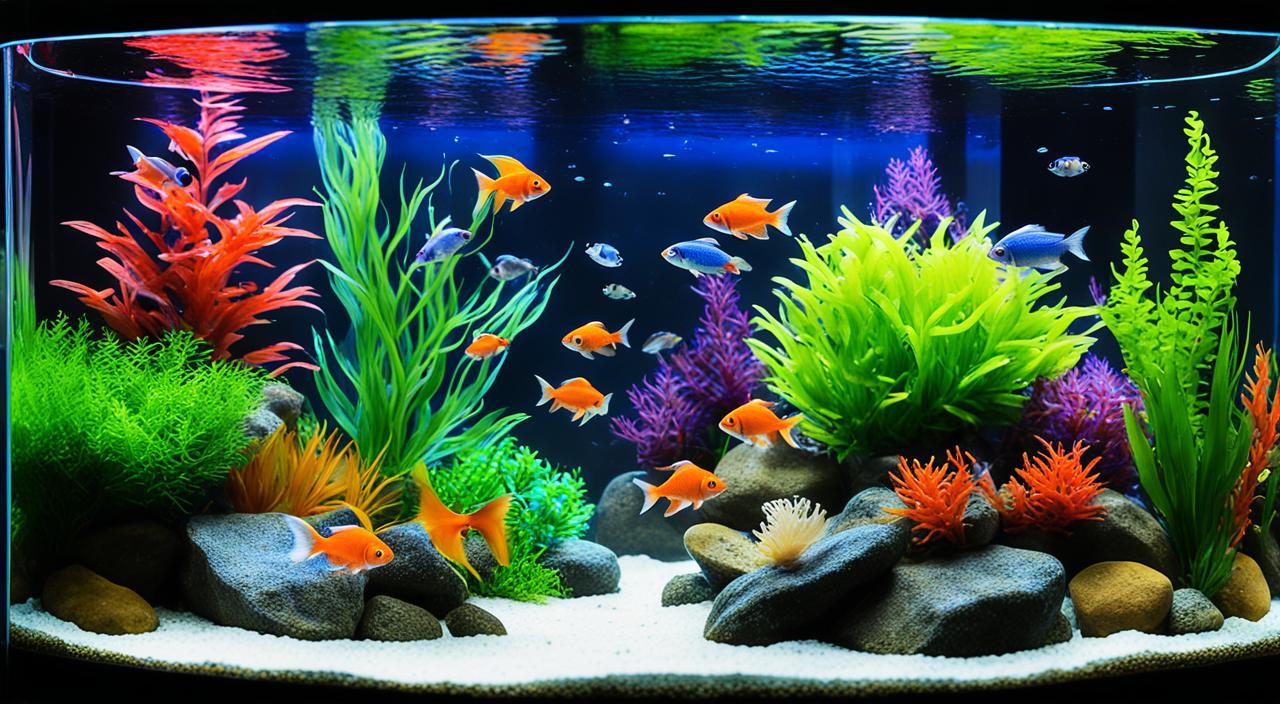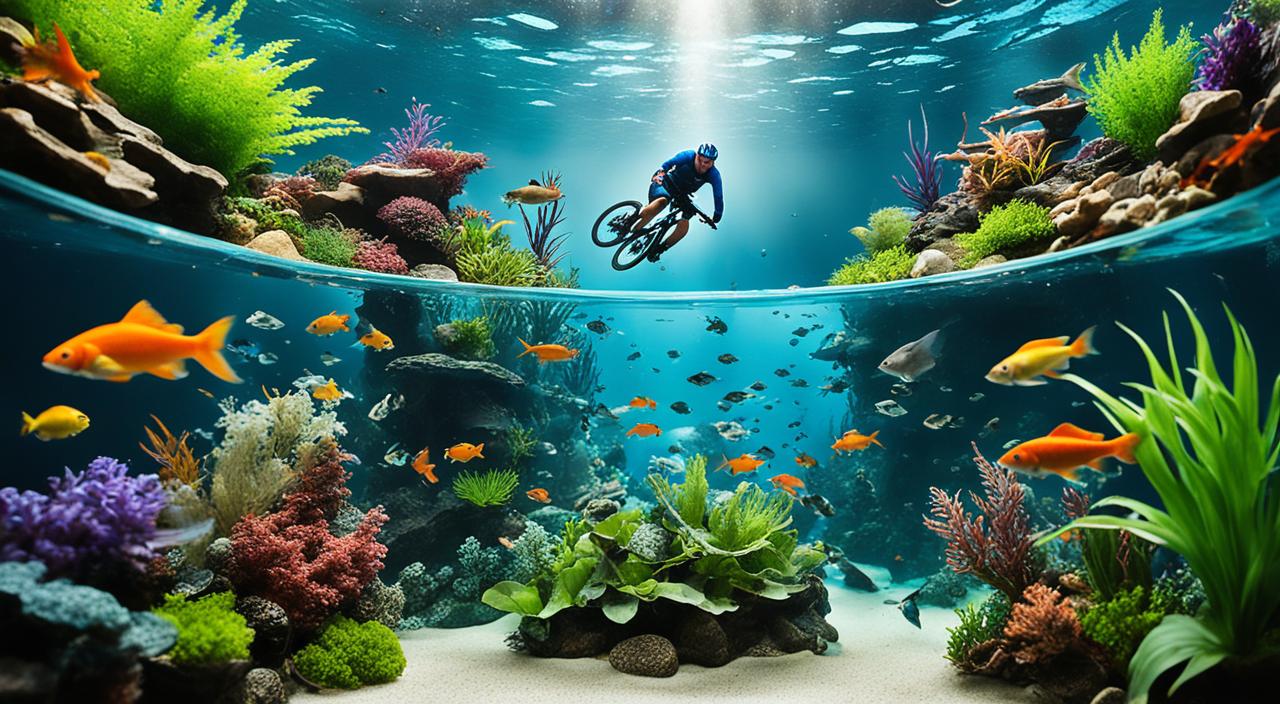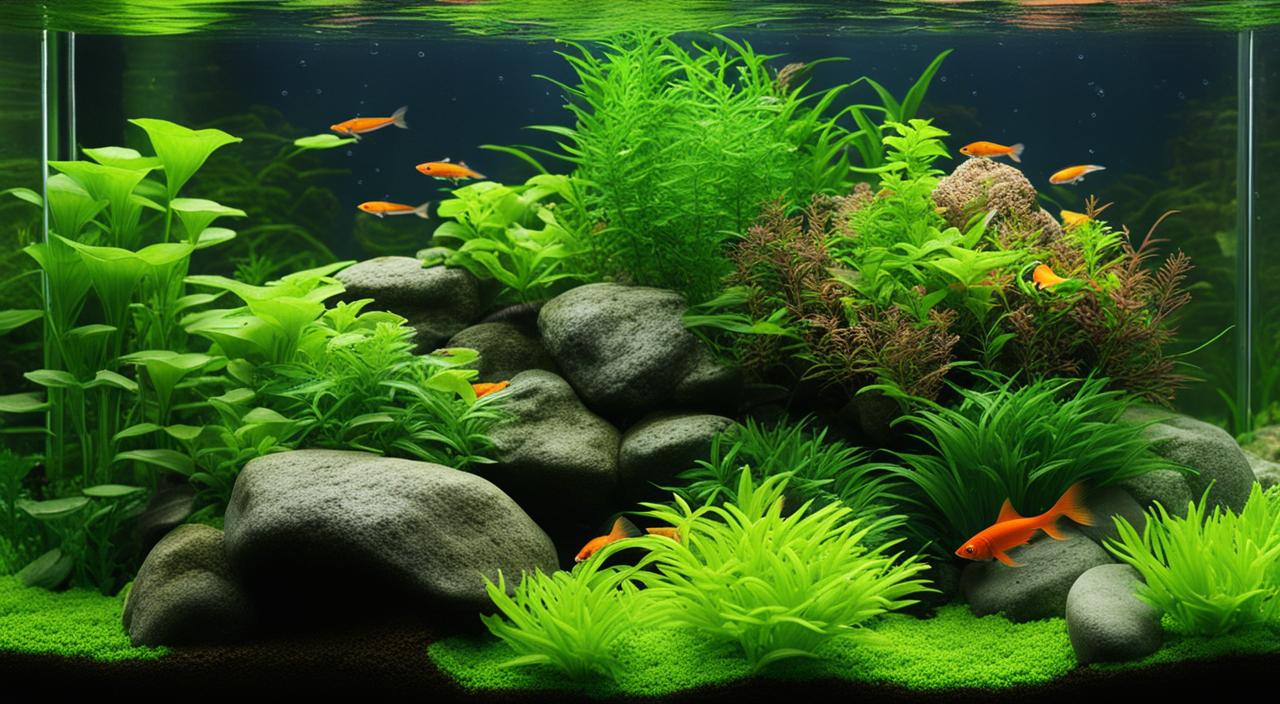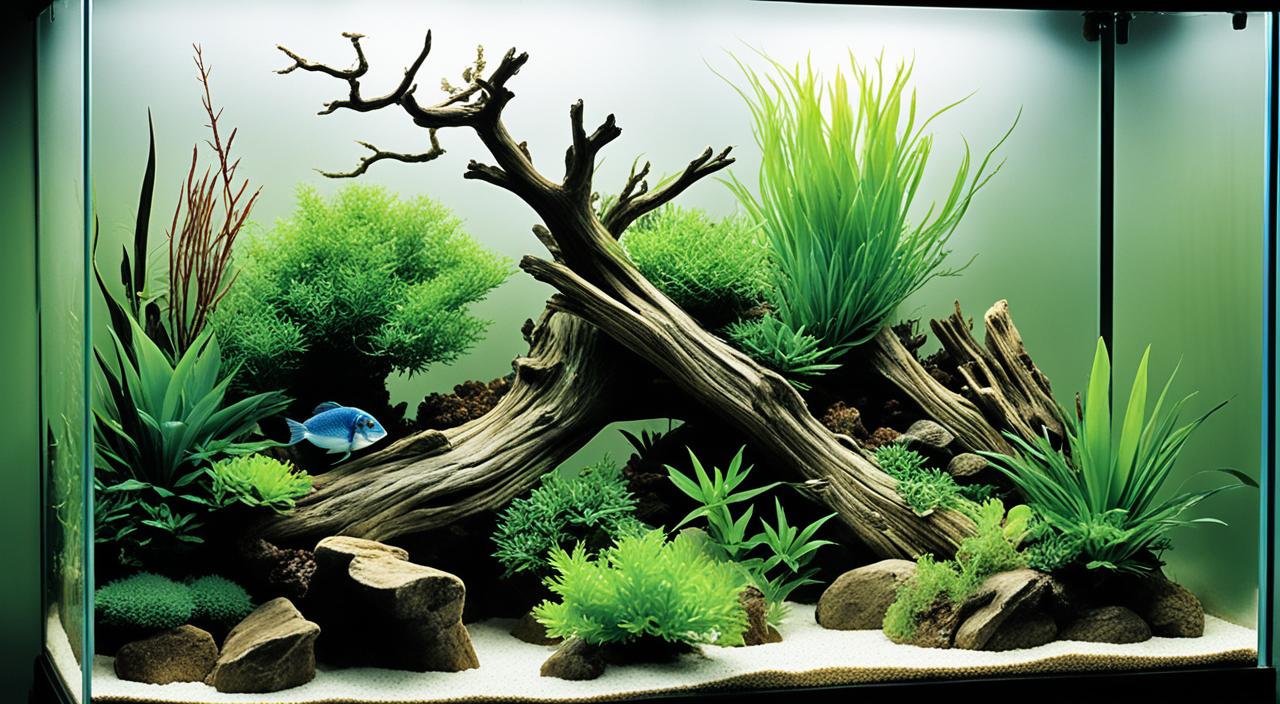When setting up a new saltwater aquarium, proper cycling is essential for the success of your tank. One of the most common methods of cycling is using live rock. Live rock, transported from the ocean, contains beneficial bacteria that help establish a healthy ecosystem in your aquarium. However, it’s essential to clean the rock before placing it in your tank and allow it to colonize for about 30-45 days. During this time, regular water testing is necessary to monitor ammonia, nitrite, and nitrate levels. Bacterial supplements can also be added to speed up the cycling process and maintain a diverse population of bacteria.
Key Takeaways:
- Live rock is an effective method for cycling a saltwater aquarium.
- Proper cleaning and colonization of live rock are crucial before introducing it to the tank.
- Regular water testing is necessary during the cycling process.
- Bacterial supplements can accelerate cycling and maintain a diverse bacterial population.
- Patience is critical in ensuring a successful cycling process.
The Nitrogen Cycle in Cycling with Live Rock
When cycling with live rock, understanding the nitrogen cycle is essential for maintaining a healthy and balanced environment in your aquarium. The nitrogen cycle is a crucial process involving converting ammonia, produced by fish waste and decaying organic matter, into less toxic forms of nitrogen compounds.
During the cycling process, beneficial bacteria establish themselves on the surface of the live rock and within the tank. These bacteria convert toxic ammonia into nitrite and break down the nitrite into nitrate.
The conversion of ammonia into nitrate is highly beneficial for your aquatic inhabitants’ overall health and well-being. While ammonia and nitrite can harm fish and other animals in high concentrations, nitrate is relatively non-toxic and can be tolerated at low levels.
Regular testing of ammonia, nitrite, and nitrate levels is necessary to ensure the nitrogen cycle is functioning correctly. Test kits specifically designed for saltwater aquariums are readily available and provide accurate measurements.
The cycling process is considered complete when ammonia and nitrite levels drop to zero and measurable nitrate levels are present in the water. This indicates that the beneficial bacteria have effectively established themselves and can convert toxic nitrogen compounds into less harmful forms.
It’s important to note that adding fish or other livestock should be done gradually and in moderation, once the cycling process is complete. This allows the biofilter, consisting of the beneficial bacteria, to adjust and prevent the sudden influx of waste that could overload the aquarium with nutrients.
Cycling with live rock takes advantage of the natural processes of the nitrogen cycle to establish a stable and thriving aquarium environment. By understanding and monitoring the nitrogen cycle, you can ensure your marine life’s overall health and well-being.
Cycling with Dry Rock: Alternative Method
An alternative method for cycling is using dry rock. Dry rock, such as AquaMaxx EcoRock or CaribSea Life Rock, is free from bacteria and dead organic matter. To properly cycle with dry rock, bacteria supplements can be added to introduce the necessary bacteria strains. Additionally, providing the aquarium with an organic material source, such as phantom feeding with fish food, helps support the growth of bacteria.
It is important to note that cycling with dry rock may take longer than live rock, but it offers advantages such as cost savings and reducing the risk of introducing unwanted hitchhikers.
Bacteria Supplements for Dry Rock Cycling
When cycling with dry rock, it is crucial to introduce beneficial bacteria to kickstart the colonization process. Bacteria supplements, such as Brightwell Aquatics MicroBacter7 or Seachem Stability, can be added to the aquarium to provide the necessary strains of bacteria.
These supplements help establish a healthy biofilter, speeding up the cycling process and promoting the breakdown of organic waste. Following the instructions provided with the supplements is essential to ensure effective bacterial colonization.
Organic Material Source for Bacterial Growth
In the absence of live rock’s natural bacterial population, providing an organic material source is essential for supporting the growth of bacteria. Phantom feeding is commonly practised in which small amounts of fish food are added to the aquarium. As the food decomposes, it acts as an organic material source, promoting bacterial growth. This helps build a robust biofilter and establishes an optimal environment for marine life. Regular monitoring of the ammonia, nitrite, and nitrate levels during cycling is necessary to ensure the bacterial population is thriving and effectively converting harmful substances.
Advantages of Cycling with Dry Rock
Cycling with dry rock offers several advantages over live rock. One of the primary benefits is cost savings since dry rock is generally less expensive compared to live rock. This can make a significant difference in the overall setup costs for aquarists on a budget. Additionally, dry rock reduces the risk of introducing unwanted hitchhikers into the aquarium, such as pests, parasites, or invasive species. By starting with a blank canvas, you have more control over the initial inhabitants of your tank, allowing for a more intentional and customized setup.
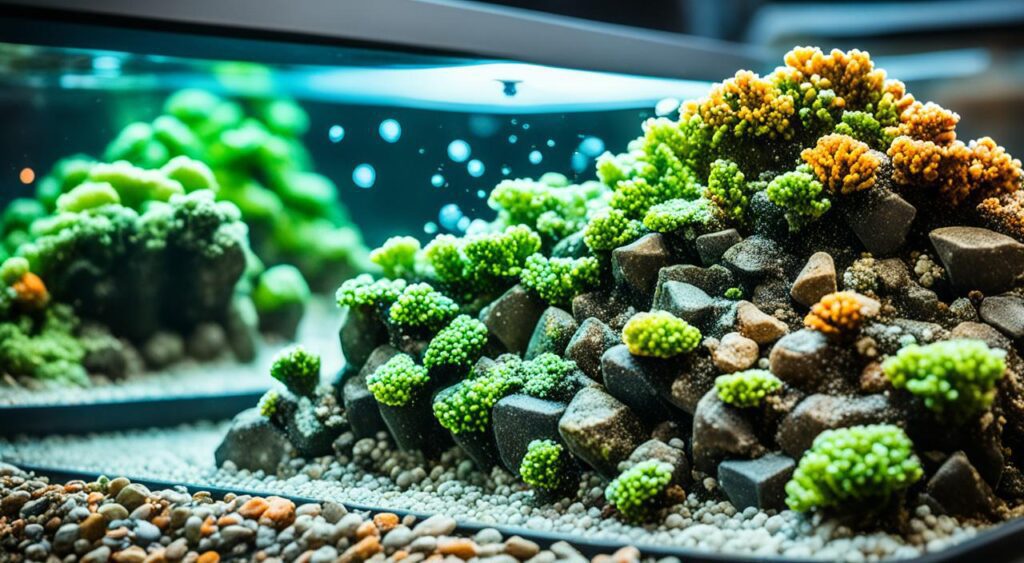
Tips for Successful Cycling with Live Rock
To ensure success in cycling with live rock, it is crucial to be patient and allow nature to take its course. Avoid adding too many fish at once or before the tank is fully cycled, as this can result in avoidable deaths and negative impacts on the ecosystem. One general rule is to add one fish per week when stocking a new tank. Regular water testing is essential during the cycling process to monitor ammonia, nitrite, and nitrate levels. Consider using bacterial supplements, like Brightwell Aquatics MicroBacter7 or Seachem Stability, to enhance the growth of beneficial bacteria and maintain a healthy and diverse bacterial population in your tank.
Essential Tips for Successful Cycling with Live Rock:
- Be patient and allow nature to take its course.
- Avoid adding too many fish at once or before the tank is fully cycled.
- Add one fish per week when stocking a new tank.
- Regularly test the water for ammonia, nitrite, and nitrate levels.
- Consider using bacterial supplements to enhance the growth of beneficial bacteria.
Following these tips, you can ensure a successful cycling process with live rock and create a thriving and sustainable aquarium environment for your marine life.

The Importance of Cycling with Live Rock
Proper cycling with live rock is crucial for the long-term success of your aquarium. When setting up a new saltwater aquarium, the cycling process helps establish a stable biological foundation and removes harmful substances like ammonia and nitrite from the water. Live rock plays a vital role in this process, as it contains beneficial bacteria that break down organic matter and recycle nutrients.
Following the recommended cycling process can create a diverse and thriving ecosystem in your aquarium. During cycling, the live rock gradually colonizes with bacteria, creating a healthy environment for your fish and other marine life. These bacteria are vital in breaking down waste materials and converting harmful substances into less toxic forms.
As you patiently allow the cycling process to progress, regular water testing is essential to monitor ammonia, nitrite, and nitrate levels. This will ensure that the water parameters stay within acceptable ranges and provide a favourable environment for your aquatic inhabitants. Cycling with live rock also helps maintain good water quality and prevents future issues, promoting your aquarium ecosystem’s overall health and well-being.
By understanding the importance of cycling with live rock and following the recommended guidelines, you can create a successful and thriving aquarium that provides a safe and healthy habitat for your fish and other marine life. Incorporating live rock in your cycling process enhances the ecosystem’s stability and promotes the growth of beneficial bacteria, resulting in a well-balanced and beautiful aquarium.
FAQ
What is the purpose of cycling with live rock in a saltwater aquarium?
Cycling with live rock helps establish a healthy ecosystem in your aquarium by introducing beneficial bacteria that break down organic matter and recycle nutrients.
How long should I allow the live rock to colonize before adding fish?
It is recommended to allow the live rock to colonize for about 30-45 days before adding fish to prevent overloading the aquarium with nutrients.
How do I know if the cycling process is complete?
The cycling process is complete when the levels of ammonia and nitrite have dropped to zero, and nitrate is present in the water. Regular water testing using test kits is essential to monitor these levels.
Can I use dry rock instead of live rock for cycling?
Yes, cycling with dry rock is an alternative method. Dry rock does not contain beneficial bacteria, but bacteria supplements can be added to introduce the necessary bacteria strains. However, cycling with dry rock may take longer compared to live rock.
How many fish should I add when stocking a new tank?
It is recommended to add one fish per week when stocking a new tank to allow the biofilter to adjust and prevent overloading the aquarium with nutrients.
Are bacterial supplements necessary for cycling with live rock?
Bacterial supplements can be used to speed up the cycling process and maintain a healthy and diverse population of bacteria in your tank. They are not necessary but can enhance the growth of beneficial bacteria.
Why is proper cycling with live rock important for the success of my aquarium?
Proper cycling with live rock establishes a stable biological foundation, ensures the removal of harmful ammonia and nitrite from the water, and creates a diverse ecosystem with beneficial bacteria that break down organic matter and recycle nutrients.

